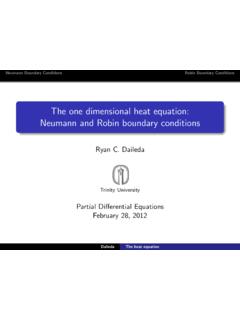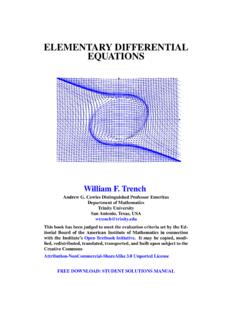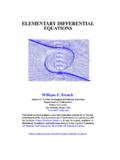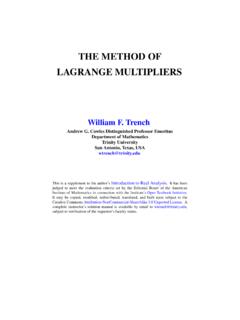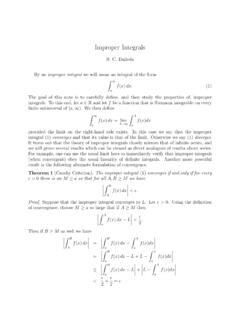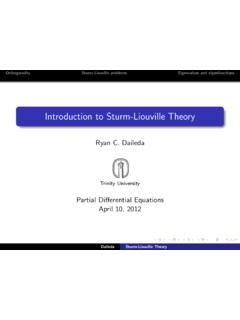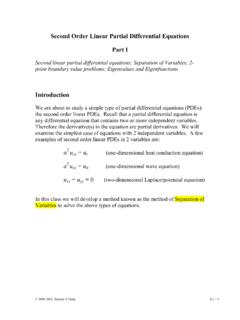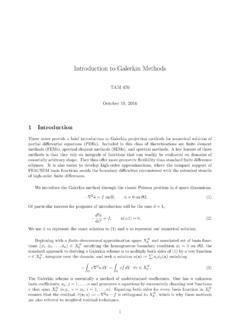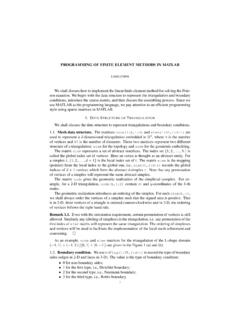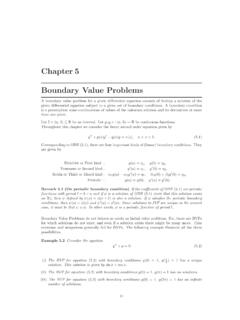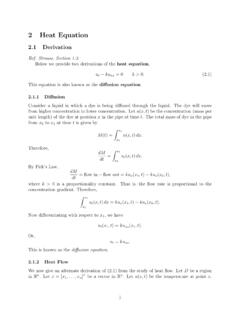Transcription of The two-dimensional heat equation - Trinity University
1 Homog. Dirichlet BCsInhomog. Dirichlet BCsHomogenizingComplete solutionThe two-dimensional heat equationRyan C. DailedaTrinity UniversityPartial Differential EquationsLecture 12 DailedaThe 2-D heat equationHomog. Dirichlet BCsInhomog. Dirichlet BCsHomogenizingComplete solutionPhysical motivationGoal:Model heat flow in a two-dimensional object (thin plate).Set up:Represent the plate by a region in thexy-plane and letu(x,y,t) ={temperature of plate at position (x,y) a fixedt, the height of the surfacez=u(x,y,t) gives thetemperature of the plate at timetand position (x,y).Under ideal assumptions( uniform density, uniform specificheat, perfect insulation along faces, no internal heat sources etc.)one can show thatusatisfies thetwo dimensional heat equationut=c2 u=c2(uxx+uyy)DailedaThe 2-D heat equationHomog. Dirichlet BCsInhomog. Dirichlet BCsHomogenizingComplete solutionRectangular plates and boundary conditionsFor now we assume:The plate is rectangular, represented byR= [0,a] [0,b].}
2 YxbaThe plate is imparted with some initial temperature:u(x,y,0) =f(x,y),(x,y) edges of the plate are held at zero degrees:u(0,y,t) =u(a,y,t) = 0,0 y b,t>0,u(x,0,t) =u(x,b,t) = 0,0 x a,t> 2-D heat equationHomog. Dirichlet BCsInhomog. Dirichlet BCsHomogenizingComplete solutionSeparation of variablesAssuming thatu(x,y,t) =X(x)Y(y)T(t),and proceeding as wedid with the 2-D wave equation , we find thatX BX= 0,X(0) =X(a) = 0,Y CY= 0,Y(0) =Y(b) = 0,T c2(B+C)T= have already solved the first two of these problems:X=Xm(x)= sin( mx), m=m a,B= 2mY=Yn(y)= sin( ny), n=n b,C= 2n,form,n then follows thatT=Tmn(t) =Amne 2mnt, mn=c 2m+ 2n=c m2a2+ 2-D heat equationHomog. Dirichlet BCsInhomog. Dirichlet BCsHomogenizingComplete solutionSuperpositionAssembling these results, we find that for anypairm,n 1 wehave the normal modeumn(x,y,t) =Xm(x)Yn(y)Tmn(t) =Amnsin( mx)sin( ny)e principle of superposition gives the general solutionu(x,y,t) = m=1 n=1 Amnsin( mx)sin( ny)e initial condition requires thatf(x,y) =u(x,y,0) = n=1 m=1 Amnsin(m ax)sin(n by),which is just the double Fourier series forf(x,y).
3 DailedaThe 2-D heat equationHomog. Dirichlet BCsInhomog. Dirichlet BCsHomogenizingComplete solutionConclusionTheoremIff(x,y)is a sufficiently nice function on[0,a] [0,b], then thesolution to the heat equation with homogeneous Dirichletboundary conditions and initial conditionf(x,y)isu(x,y,t) = m=1 n=1 Amnsin( mx) sin( ny)e 2mnt,where m=m a, n=n b, mn=c 2m+ 2n, andAmn=4ab a0 b0f(x,y)sin( mx)sin( ny)dy 2-D heat equationHomog. Dirichlet BCsInhomog. Dirichlet BCsHomogenizingComplete solutionExampleA2 2square plate withc= 1/3is heated in such a way that thetemperature in the lower half is 50, while the temperature in theupper half is 0. After that, it is insulated laterally, and thetemperature at its edges is held at 0. Find an expression that givesthe temperature in the plate fort> must solve the heat problem above witha=b= 2 andf(x,y) ={50ify 1,0ify> coefficients in the solution areAmn=42 2 20 20f(x,y)sin(m 2x)sin(n 2y)dy dx= 50 20sin(m 2x)dx 10sin(n 2y)dyDailedaThe 2-D heat equationHomog.}
4 Dirichlet BCsInhomog. Dirichlet BCsHomogenizingComplete solution= 50(2(1 + ( 1)m+1) m)(2(1 cosn 2) n)=200 2(1 + ( 1)m+1)(1 cosn 2) mn= 3 m24+n24= 6 m2+n2, the solution isu(x,y,t) =200 2 m=1 n=1((1 + ( 1)m+1)(1 cosn 2)mnsin(m 2x) sin(n 2y)e 2(m2+n2)t/36).DailedaThe 2-D heat equationHomog. Dirichlet BCsInhomog. Dirichlet BCsHomogenizingComplete solutionInhomogeneous boundary conditionsSteady state solutions and Laplace s equation2-D heat problems with inhomogeneous Dirichlet boundaryconditions can be solved by the homogenizing procedure used inthe 1-D case:1. Find and subtract the steady state(ut 0);2. Solve the resulting homogeneous problem;3. Add the steady state to the result of Step will focus only on finding the steady state part of the 0 in the 2-D heat equation gives u=uxx+uyy= 0(Laplace s equation ),solutions of which are calledharmonic 2-D heat equationHomog. Dirichlet BCsInhomog. Dirichlet BCsHomogenizingComplete solutionDirichlet problemsDefinition:TheDirichlet problemon a regionR R2is theboundary value problem u= 0 insideR,u(x,y) =f(x,y) on R.
5 U=0u x,y() =f x,y()When the region is a rectangleR= [0,a] [0,b], the boundaryconditions will be given on each edge separately as:u(x,0)=f1(x),u(x,b)=f2(x),0<x<a,u(0,y )=g1(y),u(a,y)=g2(y),0<y< 2-D heat equationHomog. Dirichlet BCsInhomog. Dirichlet BCsHomogenizingComplete solutionSolving the Dirichlet problem on a rectangle Homogenization and superpositionStrategy:Reduce to four simpler problems and use (0,y)= g (y)u(x,0)=f (x)u(a,y)=g (y)u(x,b)=f (x)2121 u= 0( )* u= 0u(0,y)= 0u(x,0)=f (x)u(a,y)=0u(x,b)=01(A)u(0,y)=0u(x,0)=0u (a,y)=0u(x,b)=f (x)2 u= 0(B)= u(0,y)=g (y)u(x,0)=0u(a,y)=0u(x,b)=01 u= 0(C)u(0,y)= 0u(x,0)=0u(a,y)=g (y)u(x,b)=02 u= 0(D)DailedaThe 2-D heat equationHomog. Dirichlet BCsInhomog. Dirichlet BCsHomogenizingComplete solutionRemarks:IfuA,uB,uCanduDsolve the Dirichlet problems (A), (B),(C) and (D), then the solution to ( ) isu=uA+uB+uC+ that the boundary conditions in (A) - (D) are allhomogeneous, with the exception of a single with inhomogeneous Neumann or robin boundaryconditions (or combinations thereof) can be reduced in asimilar 2-D heat equationHomog.
6 Dirichlet BCsInhomog. Dirichlet BCsHomogenizingComplete solutionSolution of the Dirichlet problem on a rectangleCase BGoal:Solve the boundary value problem (B): u= 0,0<x<a, 0<y<b,u(x,0)= 0,u(x,b) =f2(x),0<x<a,u(0,y)=u(a,y) = 0,0<y< (x,y) =X(x)Y(y) leads toX +kX= 0,Y kY= 0,X(0) =X(a) = 0,Y(0) = know the nontrivial solutions forXare given byX(x) =Xn(x) = sin( nx), n=n a,k= 2n(n N).DailedaThe 2-D heat equationHomog. Dirichlet BCsInhomog. Dirichlet BCsHomogenizingComplete solutionInterludeThe hyperbolic trigonometric functionsThehyperbolic cosine and sine functionsarecoshy=ey+e y2,sinhy=ey e satisfy the following identities:cosh2y sinh2y= 1,ddycoshy= sinhy,ddysinhy= can show that the general solution to the ODEY 2Y= 0can (also) be written asY=Acosh( y) +Bsinh( y).DailedaThe 2-D heat equationHomog. Dirichlet BCsInhomog. Dirichlet BCsHomogenizingComplete solutionUsing = nandY(0) = 0, we findY(y)=Yn(y) =Ancosh( ny) +Bnsinh( ny)0=Yn(0) =Ancosh 0 +Bnsinh 0= yields the separated solutionsun(x,y) =Xn(x)Yn(y)=Bnsin( nx) sinh( ny),and superposition gives the general solutionu(x,y) = n=1 Bnsin( nx) sinh( ny).
7 Finally, the top edge boundary condition requires thatf2(x) =u(x,b)= n=1 Bnsinh ( nb) sin ( nx).DailedaThe 2-D heat equationHomog. Dirichlet BCsInhomog. Dirichlet BCsHomogenizingComplete solutionConclusionAppealing to the formulae for sine series coefficients, we can nowsummarize our (x)is piecewise smooth, the solution to the Dirichlet problem u= 0,0<x<a,0<y<b,u(x,0) = 0,u(x,b) =f2(x),0<x<a,u(0,y) =u(a,y) = 0,0<y< (x,y) = n=1 Bnsin( nx) sinh( ny),where n=n aandBn=2asinh( nb) a0f2(x) sin( nx) 2-D heat equationHomog. Dirichlet BCsInhomog. Dirichlet BCsHomogenizingComplete solutionRemark:If we know the sine series expansion forf2(x) on [0,a],then we can use the relationshipBn=1sinh( nb)(nth sine coefficient off2).ExampleSolve the Dirichlet problem on the square[0,1] [0,1], subject tothe boundary conditionsu(x,0) = 0,u(x,1) =f2(x),0<x<1,u(0,y) =u(1,y) = 0,0<y< (x) ={75xif0 x 23,150(1 x)if23<x 2-D heat equationHomog.}
8 Dirichlet BCsInhomog. Dirichlet BCsHomogenizingComplete solutionWe havea=b= graph off2(x) is:According to exercise (withp= 1,a= 2/3 andh= 50),the sine series forf2is:f2(x) =450 2 n=1sin(2n 3)n2sin(n x).DailedaThe 2-D heat equationHomog. Dirichlet BCsInhomog. Dirichlet BCsHomogenizingComplete solutionThus,Bn=1sinh(n )(450 2sin(2n 3)n2)=450 2sin(2n 3)n2sinh(n ),andu(x,y) =450 2 n=1sin(2n 3)n2sinh(n )sin(n x) sinh(n y). 2-D heat equationHomog. Dirichlet BCsInhomog. Dirichlet BCsHomogenizingComplete solutionSolution of the Dirichlet problem on a rectangleComplete solutionRecall:u(0,y)= g (y)u(x,0)=f (x)u(a,y)=g (y)u(x,b)=f (x)2121 u= 0( )* u= 0u(0,y)= 0u(x,0)=f (x)u(a,y)=0u(x,b)=01(A)u(0,y)=0u(x,0)=0u (a,y)=0u(x,b)=f (x)2 u= 0(B)= u(0,y)=g (y)u(x,0)=0u(a,y)=0u(x,b)=01 u= 0(C)u(0,y)= 0u(x,0)=0u(a,y)=g (y)u(x,b)=02 u= 0(D)DailedaThe 2-D heat equationHomog. Dirichlet BCsInhomog. Dirichlet BCsHomogenizingComplete solutionSolution of the Dirichlet problem on a rectangleCases A and CSeparation of variables shows that the solution to (A) isuA(x,y) = n=1 Ansin(n xa)sinh(n (b y)a),whereAn=2asinh(n ba) a0f1(x) sin(n xa) , the solution to (C) isuC(x,y) = n=1 Cnsinh(n (a x)b)sin(n yb),withCn=2bsinh(n ab) b0g1(y) sin(n yb) 2-D heat equationHomog.
9 Dirichlet BCsInhomog. Dirichlet BCsHomogenizingComplete solutionSolution of the Dirichlet problem on a rectangleCase DAnd the solution to (D) isuD(x,y) = n=1 Dnsinh(n xb)sin(n yb),whereDn=2bsinh(n ab) b0g2(y) sin(n yb) :The coefficients in each case are just multiples of theFourier sine coefficients of the nonzero boundary condition, (n ab)(nth sine coefficient ofg2on [0,b]).DailedaThe 2-D heat equationHomog. Dirichlet BCsInhomog. Dirichlet BCsHomogenizingComplete solutionExampleSolve the Dirichlet problem on[0,1] [0,2]with the followingboundary conditions . u = 02u=2u=0u=(2-y) /22We havea= 1,b= 2andf1(x) = 2,f2(x) = 0,g1(y) =(2 y)22,g2(y) = 2 2-D heat equationHomog. Dirichlet BCsInhomog. Dirichlet BCsHomogenizingComplete solutionIt follows thatBn= 0 for alln,and the remaining coefficients weneed areAn=21 sinh(n 21) 102 sin(n x1)dx=4(1 + ( 1)n+1)n sinh (2n ),Cn=22 sinh(n 12) 20(2 y)22sin(n y2)dy=4( 2n2 2 + 2( 1)n)n3 3sinh(n 2),Dn=22 sinh(n 12) 20(2 y) sin(n y2)dy=4n sinh(n 2).
10 DailedaThe 2-D heat equationHomog. Dirichlet BCsInhomog. Dirichlet BCsHomogenizingComplete solutionThe complete solution is thusu(x,y) =uA(x,y) +uC(x,y) +uD(x,y)= n=14(1 + ( 1)n+1)n sinh(2n )sin(n x) sinh(n (2 y))+ n=14(n2 2 2 + 2( 1)n)n3 3sinh(n 2)sinh(n (1 x)2)sin(n y2)+ n=14n sinh(n 2)sinh(n x2)sin(n y2).DailedaThe 2-D heat equationHomog. Dirichlet BCsInhomog. Dirichlet BCsHomogenizingComplete solution= DailedaThe 2-D heat equatio
